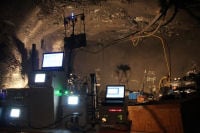Mining Topic: Diesel Exhaust
What is the health and safety problem?
Exposure to elevated diesel exhaust concentrations has been linked to negative health effects such as eye and nose irritation, headaches, nausea, and asthma. Diesel particulate matter (DPM) has been classified as a possible carcinogen by both the National Institute for Occupational Safety and Health (NIOSH) and the Environmental Protection Agency (EPA). Diesel engines are a major contributor to elevated concentrations of carbon monoxide, carbon dioxide, oxides of nitrogen, and hydrocarbons in underground coal and metal/nonmetal mines.
What is the extent of the problem?
Currently, underground miners can be exposed to more than 100 times the typical environmental concentration of diesel exhaust and more than 10 times what might be found in other workplaces. As mines add more and more pieces of diesel equipment the potential overexposure becomes an even greater risk.
How is the NIOSH Mining program addressing this problem?

Experimental diesel exhaust monitoring and testing platform installed in an underground mine.
The NIOSH Mining Program is working to reduce respiratory diseases in miners associated with diesel emissions by reducing miners' exposure to these emissions in underground mines. This goal is addressed by evaluating methods to control emissions from diesel equipment and by developing new monitoring techniques that identify exposure limits in order to reduce potential overexposures.
What are the significant findings?
NIOSH research has resulted in a method to continuously monitor personal exposure to diesel particulate matter in underground mines. This monitoring device has been licensed and is currently being sold commercially. In addition, NIOSH research has evaluated numerous control technologies to reduce emissions from diesel equipment. Evaluated control technologies include diesel particulate filters, alternative fuels (biodiesel), emissions-assisted maintenance programs, and fuel additives.
What are the next steps?
The NIOSH diesel research group will continue both laboratory and field evaluations of novel and emerging technologies to control diesel emissions including modern engines, exhaust aftertreatment technologies, and alternative fuels. In addition, NIOSH researchers will continue research on the properties of aerosols emitted by diesel engines and aftertreatment systems.
Visit our Site Browser to see a search returning all pages tagged with Diesel Exhaust, including the Noteworthy Publications & Products listed below. Once there, you can continue to add or remove search terms to find the information you need.
- Aerosols Emitted in Underground Mine Air by Diesel Engine Fueled with Biodiesel
- A Computer Software Program that Estimates Air Quantity Requirements in Large Opening Stone Mines
- DEEP Project on Evaluation of Diesel Particulate Filters at Inco's Stobie Mine
- Diesel Aerosols and Gases in Underground Mines: Guide to Exposure Assessment and Control
- Diesel Exhaust Aerosol, Review of Measurement Technology
- Differential Pressure as a Measure of Particulate Matter Emissions from Diesel Engines
- Effectiveness of Selected Diesel Particulate Matter Control Technologies for Underground Mining Applications: Isolated Zone Study, 2003
- Effectiveness of Selected Diesel Particulate Matter Control Technologies for Underground Mining Applications: Isolated Zone Study, 2004
- The Effectiveness of Selected Technologies in Controlling Diesel Emissions in an Underground Mine: Isolated Zone Study at Stillwater Mining Company's Nye Mine
- Effects of Diesel Exhaust Aftertreatment Devices on Concentrations and Size Distribution of Aerosols in Underground Mine Air
- Evaluation of the Approach to Respirable Quartz Exposure Control in U.S. Coal Mines
- Evaluation of the SKC� DPM Cassette for Monitoring Diesel Particulate Matter in Coal Mines
- Instrumentation for Diesel Particulate Matter Emissions Research
- Mutagenicity of Diesel Exhaust Particles from an Engine with Differing Exhaust After Treatments
- Relationship Between Elemental Carbon, Total Carbon, and Diesel Particulate Matter in Several Underground Metal/nonmetal Mines
- Retrofitting and Re-powering as a Control Strategies for Curtailment of Exposure of Underground Miners to Diesel Aerosols
- Technology News 514 - The Air Quantity Estimator (AQE): A New Computer Software Tool for Large-opening Mine Ventilation Planning